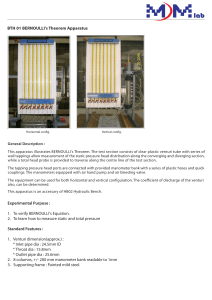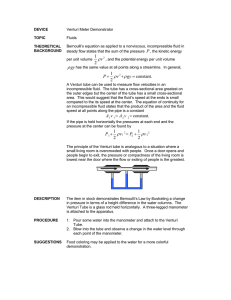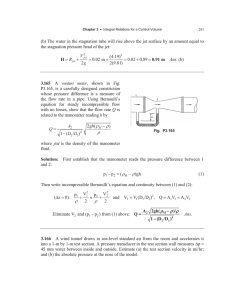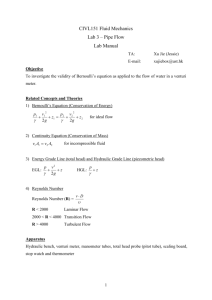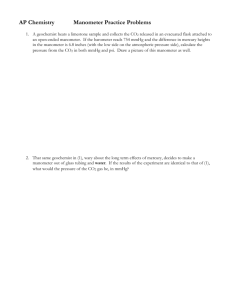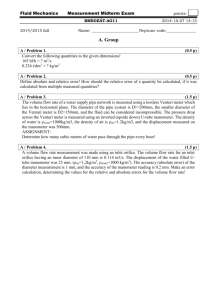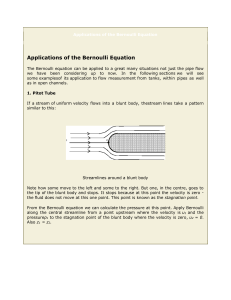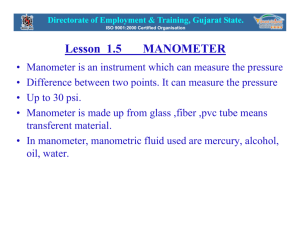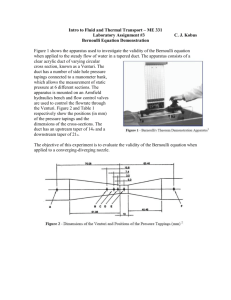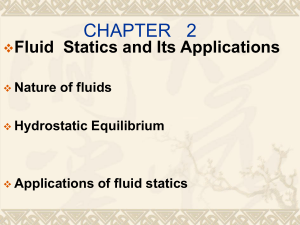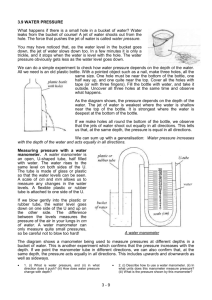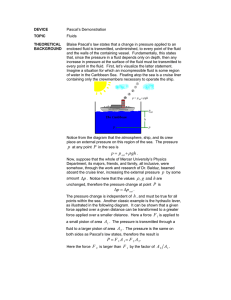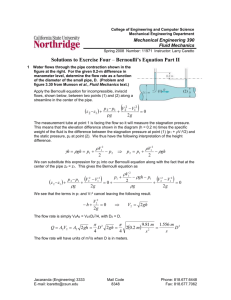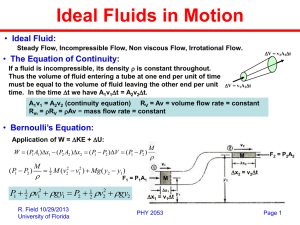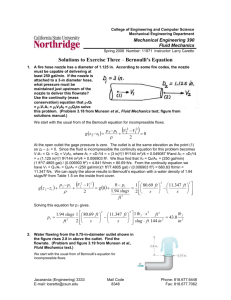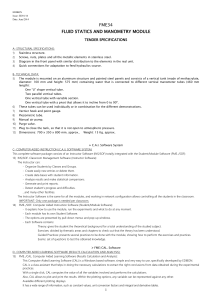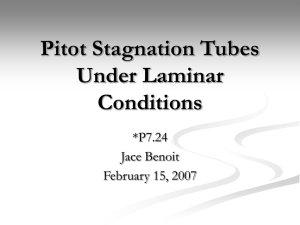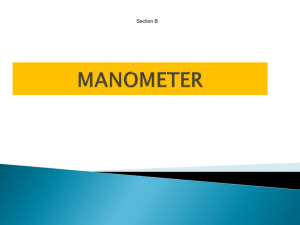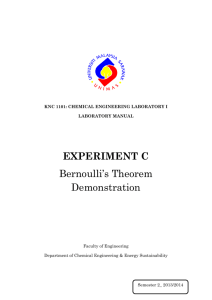Unit 4: February 26
advertisement
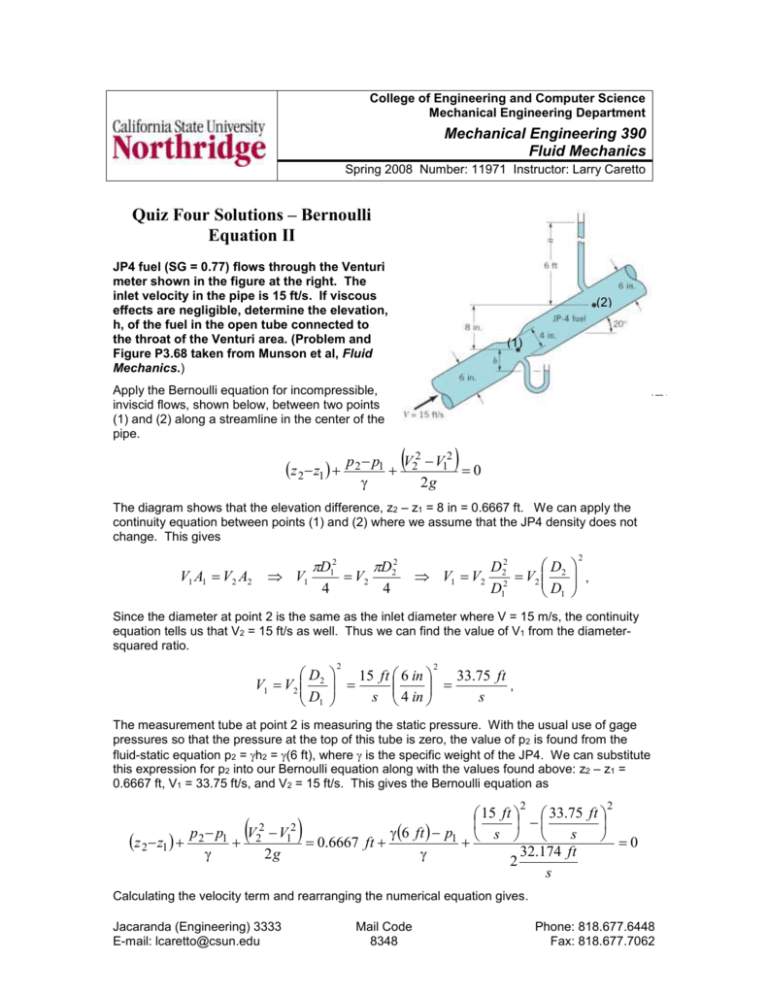
College of Engineering and Computer Science Mechanical Engineering Department Mechanical Engineering 390 Fluid Mechanics Spring 2008 Number: 11971 Instructor: Larry Caretto Quiz Four Solutions – Bernoulli Equation II JP4 fuel (SG = 0.77) flows through the Venturi meter shown in the figure at the right. The inlet velocity in the pipe is 15 ft/s. If viscous effects are negligible, determine the elevation, h, of the fuel in the open tube connected to the throat of the Venturi area. (Problem and Figure P3.68 taken from Munson et al, Fluid Mechanics.) Apply the Bernoulli equation for incompressible, inviscid flows, shown below, between two points (1) and (2) along a streamline in the center of the pipe. z 2 z1 (2) (1) p 2 p1 V22 V12 0 2g The diagram shows that the elevation difference, z2 – z1 = 8 in = 0.6667 ft. We can apply the continuity equation between points (1) and (2) where we assume that the JP4 density does not change. This gives V1 A1 V2 A2 V1 D12 V2 4 D22 4 D D2 V1 V2 22 V2 2 D1 D1 2 , Since the diameter at point 2 is the same as the inlet diameter where V = 15 m/s, the continuity equation tells us that V2 = 15 ft/s as well. Thus we can find the value of V1 from the diametersquared ratio. D V1 V2 2 D1 2 2 15 ft 6 in 33.75 ft , s 4 in s The measurement tube at point 2 is measuring the static pressure. With the usual use of gage pressures so that the pressure at the top of this tube is zero, the value of p2 is found from the fluid-static equation p2 = h2 = (6 ft), where is the specific weight of the JP4. We can substitute this expression for p2 into our Bernoulli equation along with the values found above: z2 – z1 = 0.6667 ft, V1 = 33.75 ft/s, and V2 = 15 ft/s. This gives the Bernoulli equation as z 2 z1 p 2 p1 V22 V12 2g 2 2 15 ft 33.75 ft 6 ft p1 s s 0 0.6667 ft 32 . 174 ft 2 s Calculating the velocity term and rearranging the numerical equation gives. Jacaranda (Engineering) 3333 E-mail: lcaretto@csun.edu Mail Code 8348 Phone: 818.677.6448 Fax: 818.677.7062 Quiz four solutions ME 390, L. S. Caretto, Spring 2008 0.6667 ft 6 ft p1 14.205 ft 0 Page 2 p1 7.538 ft The manometer at the Venturi throat is open to the atmosphere so the pressure on the open arm is zero. Since the bottom of the displacement h is at the same level as the open arm of the manometer the pressure at this level on the left side of the manometer is zero. This must be less than the pressure at point 1, p1, by the specific weight, , times the height, h, that we are trying to find. This gives the manometer equation as follows. p1 h 0 h p1 7.538 ft We see that the manometer height is p1/ which is the same quantity whose numerical value we found as –7.538 ft from Bernoulli’s equation. This gives us our answer for the manometer height: h = 7.538 ft What would your answer be if the fluid were water? The above analysis shows that the specific gravity does not play a role in the solution so the answer would be the same, h = 7.538 ft , if the fluid were water.
